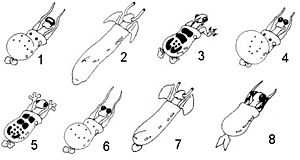Caminalcules

Caminalcules (from Camin and animalcule) are a group of animal-like life forms invented by Professor Joseph H. Camin (University of Kansas) as a tool for understanding phylogenetics. Interested in how taxonomists group species, he designed these creatures to show an evolutionary pattern of divergence and diversification in morphology. There are 29 recent 'species' of Caminalcules and 48 fossil forms.
The Caminalcules first appeared in print in the journal Systematic Zoology (now Systematic Biology) in 1983, four years after Camin's death in 1979.[1] Robert R. Sokal published four papers,[2][3][4][5] the first showing the full set of Caminacules and the second using them to compare methods in numerical taxonomy. They have been used in biology education to teach the principles of systematics and evolution.
References
- ↑ Coil, W. H.; M. Stanley (August 1980). "Joseph H. Camin: 6 June 1922-28 July 1979". The Journal of Parasitology 66 (4): 703. JSTOR 3280546.
- ↑ Sokal, R. R. (June 1983). "A phylogenetic analysis of the Caminalcules. I. The data base". Systematic Zoology 32 (2): 159–184. doi:10.2307/2413279. JSTOR 2413279.
- ↑ Sokal, R. R. (June 1983). "A phylogenetic analysis of the Caminalcules. II. Estimating the true cladogram". Systematic Zoology 32 (2): 185–201. doi:10.2307/2413280. JSTOR 2413280.
- ↑ Sokal, R. R. (September 1983). "A phylogenetic analysis of the Caminalcules. III. Fossils and Classification". Systematic Zoology 32 (3): 248–258. doi:10.2307/2413445. JSTOR 2413445.
- ↑ Sokal, R. R. (September 1983). "A phylogenetic analysis of the Caminalcules. IV. Congruence and Character Stability". Systematic Zoology 32 (3): 259–275. doi:10.2307/2413446. JSTOR 2413446.
Further reading
- Sokal, R. R.; K. L. Fiala; G. Hart (December 1984). "OTU Stability and Factors Determining Taxonomic Stability: Examples from the Caminalcules and the Leptopodomorpha". Systematic Zoology 33 (4): 387–407. doi:10.2307/2413091. JSTOR 2413091.
- Holman, E. W. (June 1986). "A Taxonomic Difference Between the Caminalcules and Real Organisms". Systematic Zoology 35 (2): 259–261. doi:10.2307/2413437. JSTOR 2413437.
- Gendron, R. P. (October 2000). "The Classification & Evolution of Caminalcules". The American Biology Teacher 62 (8): 570–576. doi:10.1662/0002-7685(2000)062[0570:TCEOC]2.0.CO;2. JSTOR 4450980.
External links
- The Evolution of Caminalcules - "Caminalcules, Snouters and Other Unusual Creatures"
- Biology 10 Lab Manual Caminalcules activity on Taxonomy and phylogeny, Harris, K (2010)
- Chasing after Caminalcules Inquiry-Based Science Education activity based on Caminalcules, Domènech, J. (2013)